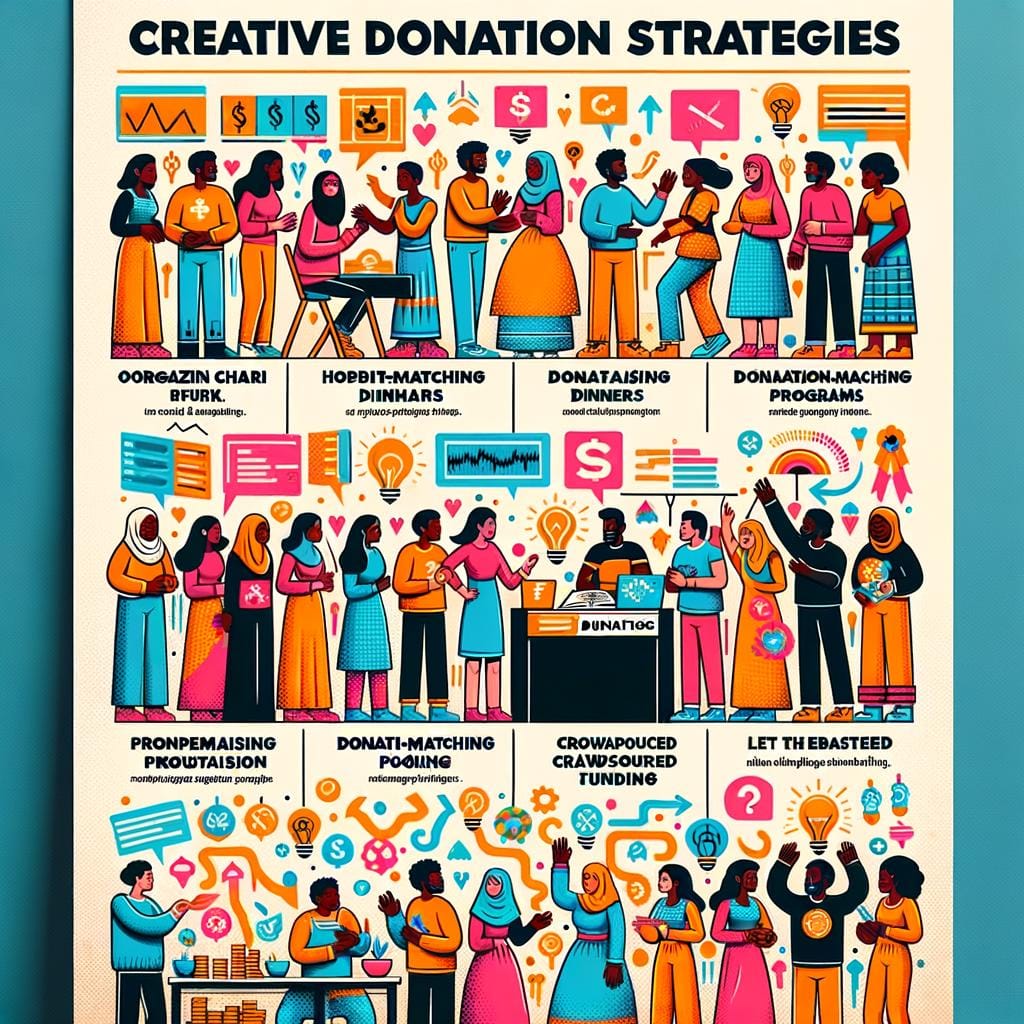Donation strategies play a crucial role in maximizing fundraising efforts for organizations of all sizes. Developing a strategic approach to donation campaigns can significantly impact the success and reach of fundraising initiatives. By strategically planning donation strategies, organizations can align their goals with the resources available and effectively engage potential donors.
Setting specific and achievable donation goals is a key component of donation strategies. By clearly defining objectives, organizations can track progress, measure success, and motivate donors to contribute towards a common target. These goals act as a roadmap for fundraising efforts, providing direction and focus for donation campaigns.
Identifying target donors is another essential element of successful donation strategies. Understanding the demographics, interests, and motivations of potential donors allows organizations to tailor their messaging and outreach efforts effectively. By implementing targeted strategies to reach out to specific donor segments, organizations can increase engagement and maximize donations from their desired audience.
Setting Goals
Setting specific and achievable donation goals is essential in any successful fundraising campaign. Before diving into the execution of donation strategies, organizations must first establish clear objectives that are measurable and attainable. By having well-defined goals, nonprofits can monitor their progress, evaluate their effectiveness, and adjust their approach as needed.
When determining donation goals, organizations should consider factors such as their financial needs, the scope of the project or program being funded, and the timeline for fundraising. It is important to set both short-term and long-term goals to provide a roadmap for fundraising efforts. By breaking down larger targets into smaller milestones, nonprofits can create a sense of progress and momentum that motivates donors to contribute.
One effective strategy for setting donation goals is to analyze past fundraising campaigns and assess what worked well and where improvements can be made. By learning from previous experiences, organizations can refine their approach and set more accurate targets for future campaigns.
Additionally, nonprofits should also take into account external factors such as economic conditions, donor preferences, and current events that may impact donation levels. By conducting thorough research and planning, organizations can establish realistic and impactful donation goals that align with their mission and vision.
Overall, setting specific and achievable donation goals is crucial in guiding fundraising efforts towards success. By carefully defining objectives, analyzing past performance, and considering external factors, organizations can create a roadmap for achieving their financial targets. Through strategic goal-setting, nonprofits can maximize the effectiveness of their donation strategies and ultimately drive more support towards their cause.
Identifying Target Donors
When it comes to successful donation strategies, one key aspect is identifying the right target donors. By focusing on individuals or groups who are most likely to be interested in supporting your cause, you can maximize your fundraising efforts and increase the likelihood of receiving donations. Here are some strategies for identifying and reaching out to potential donors:
1. Conduct Research: Start by conducting thorough research to identify individuals or organizations that have a history of supporting causes similar to yours. Look for donors who have a connection to your mission or who have expressed interest in similar issues.
2. Network Effectively: Networking plays a crucial role in identifying potential donors. Attend relevant events, conferences, and meetings where you can meet like-minded individuals who may be interested in supporting your cause. Make use of online platforms such as LinkedIn to connect with potential donors.
3. Segment Your Donors: Once you have identified potential donors, segment them based on their interests, giving capacity, and relationship with your organization. This will allow you to tailor your outreach efforts and communication strategies to each group effectively.
By implementing these strategies for identifying and reaching out to potential donors, you can increase the success of your donation campaigns and build lasting relationships with supporters who are passionate about your cause. Remember that cultivating meaningful connections with donors is essential for long-term success in fundraising efforts.
Utilizing Online Platforms
Expanding Reach and Accessibility
One of the key advantages of using online platforms for donations is the ability to expand reach and accessibility. With just a few clicks, individuals from across the globe can make contributions to your cause. This allows organizations to tap into a larger pool of potential donors who may not have been reached through traditional fundraising methods. Additionally, online platforms make it easier for donors to contribute at any time, providing convenience and flexibility that can encourage more donations.
Streamlining Donation Processes
Another benefit of utilizing online platforms is the ability to streamline donation processes. Through user-friendly interfaces and secure payment gateways, donors can easily make contributions without any hassle. This quick and efficient process not only makes it more convenient for donors but also increases the likelihood of receiving donations. Additionally, online platforms often allow for recurring donations, making it easier for donors to continue supporting your cause on a regular basis.
Tracking and Analyzing Data
Online platforms also offer the advantage of tracking and analyzing data related to donations and fundraising campaigns. By leveraging analytics tools, organizations can gain insights into donor behavior, preferences, and trends. This valuable information can help tailor donation strategies to better resonate with donors and improve fundraising efforts. By monitoring metrics such as donation amounts, conversion rates, and engagement levels, nonprofits can make data-driven decisions that lead to more effective donation strategies.
Leveraging Social Media
In today’s digital age, leveraging social media has become a critical component of any successful donation strategy. With billions of active users on platforms like Facebook, Instagram, and Twitter, social media provides a powerful tool for reaching a wide audience and promoting donation campaigns effectively. Here are some strategies on how organizations can effectively use social media to maximize their fundraising efforts:
- Create engaging content: In order to capture the attention of potential donors on social media, it is essential to create compelling and visually appealing content. This can include impactful images, videos, and stories that convey the mission and impact of the organization. By evoking emotion and connecting with audiences on a personal level, organizations can inspire followers to take action and make donations.
- Utilize targeted advertising: Social media platforms offer advanced targeting options that allow organizations to reach specific demographics based on factors such as location, interests, and behaviors. By utilizing these capabilities, organizations can ensure that their donation campaigns are seen by the right audience most likely to support their cause. This targeted approach can help maximize the effectiveness of fundraising efforts and drive more donations.
- Engage with followers: Building a strong presence on social media involves more than just posting content – it also requires engaging with followers through comments, messages, and interactive features. By responding promptly to inquiries, thanking donors publicly for their contributions, and fostering conversations around the organization’s mission, organizations can cultivate a loyal community of supporters who are more likely to donate and advocate for the cause.
Incorporating these strategies into an organization’s donation strategies can significantly enhance their fundraising efforts and ultimately lead to greater success in achieving donation goals. By harnessing the power of social media to reach a broader audience, connect emotionally with potential donors, and foster engagement within their online communities, organizations can effectively promote their donation campaigns and inspire individuals to contribute towards making a positive impact in the world.
With thoughtful planning and consistent implementation of these tactics, organizations can leverage social media as a valuable tool in maximizing their fundraising efforts.
Crafting Compelling Stories
When crafting compelling stories for donation campaigns, it is essential to focus on the impact of the donations and how they can make a difference. Personal anecdotes, testimonials from those who have benefited from the donations, and real-life examples can help illustrate the significance of the cause and motivate donors to contribute. By highlighting the positive outcomes and changes that donations can bring about, you can effectively communicate the importance of supporting your organization or campaign.
Furthermore, utilizing multimedia elements such as videos, images, and graphics can enhance the storytelling experience and make it more engaging for donors. Visual aids can help create a more immersive storytelling environment, allowing donors to connect on a deeper level with the cause. By incorporating different forms of media into your storytelling approach, you can capture the attention of potential donors and effectively convey your message to inspire them to donate.
| Aspect | Importance |
|---|---|
| Emotional Connection | Creates empathy in potential donors |
| Impact Illustration | Demonstrates how donations make a difference |
| Multimedia Integration | Enhances storytelling experience for donors |
Implementing Matching Gift Programs
Securing Matching Gift Partners
One key aspect of implementing matching gift programs is securing partnerships with companies or individuals willing to match donations. Organizations can approach businesses within their community that have a history of supporting charitable causes or reach out to individual donors who are passionate about their mission. Establishing clear guidelines for matching gift contributions and ensuring transparency in the process can help build trust and encourage more participants to join in on the initiative.
Promoting Matching Gift Opportunities
To maximize the effectiveness of matching gift programs, it is essential to actively promote these opportunities to potential donors. Utilizing various communication channels, such as emails, social media posts, and website banners, can raise awareness about matching gift initiatives and encourage more individuals to participate. Highlighting success stories of how matching gifts have doubled the impact of donations can also inspire others to get involved and contribute towards the cause.
Tracking and Reporting Matching Gifts
As donations come in through matching gift programs, it is important for organizations to track and report these contributions accurately. Keeping thorough records of matched donations and providing timely updates on progress towards fundraising goals can help maintain transparency with supporters. Recognizing both the original donor and the matching partner for their combined impact can also foster a sense of appreciation and gratitude within the donor community, ultimately leading to stronger relationships and continued support.
Building Donor Relationships
In conclusion, developing effective donation strategies is key to maximizing fundraising efforts and ensuring the sustainability of charitable organizations. Setting clear and achievable donation goals, identifying target donors, utilizing online platforms, leveraging social media, crafting compelling stories, implementing matching gift programs, and building donor relationships are all important components of a successful donation strategy.
One crucial aspect of donation strategies is building strong donor relationships. By engaging with donors on a personal level, understanding their motivations for giving, and expressing gratitude for their support, organizations can foster long-term connections that encourage repeat donations. It is essential to communicate regularly with donors, provide updates on how their contributions are making an impact, and involve them in the organization’s mission and projects.
The implementation of effective donation strategies not only helps raise funds but also strengthens the bond between donors and organizations. By employing a combination of these strategies and continuously evaluating and adjusting approaches based on feedback and results, nonprofits can create sustainable donation campaigns that resonate with supporters and drive meaningful impact in their communities. Ultimately, focusing on building donor relationships will not only increase donations but also cultivate a loyal donor base dedicated to furthering the organization’s cause.
Frequently Asked Questions
What Is the Most Effective Way to Donate?
The most effective way to donate is to research and find reputable organizations that align with your values and have a proven track record of making a difference. Consider donating money, time, or resources based on the specific needs of the organization.
What Is an Example of a Major Donor Strategy?
A major donor strategy involves cultivating relationships with individuals who have the capacity to make significant financial contributions to a cause or organization. This may include personalized communication, exclusive events, and recognition for their generosity to encourage continued support.
What Is Donor Strategy?
Donor strategy refers to the plan and approach that non-profit organizations use to attract, retain, and engage donors. This includes understanding the motivations of donors, creating targeted campaigns, building relationships, and showing appreciation for their contributions to ensure long-term support.

Hello, I’m April Denton, your go-to expert for all things home decluttering and organization. With over a decade of experience helping individuals transform their living spaces into serene, clutter-free sanctuaries, I am passionate about the life-changing benefits of decluttering. My journey into the world of organization began out of necessity, juggling a busy career and a bustling household. I quickly realized that a well-organized home was the key to a more balanced, stress-free life.





